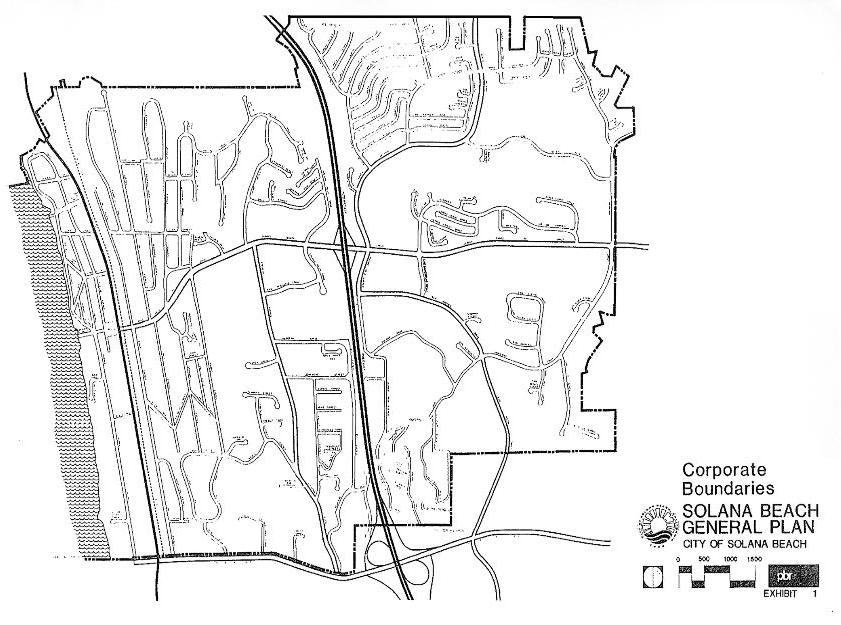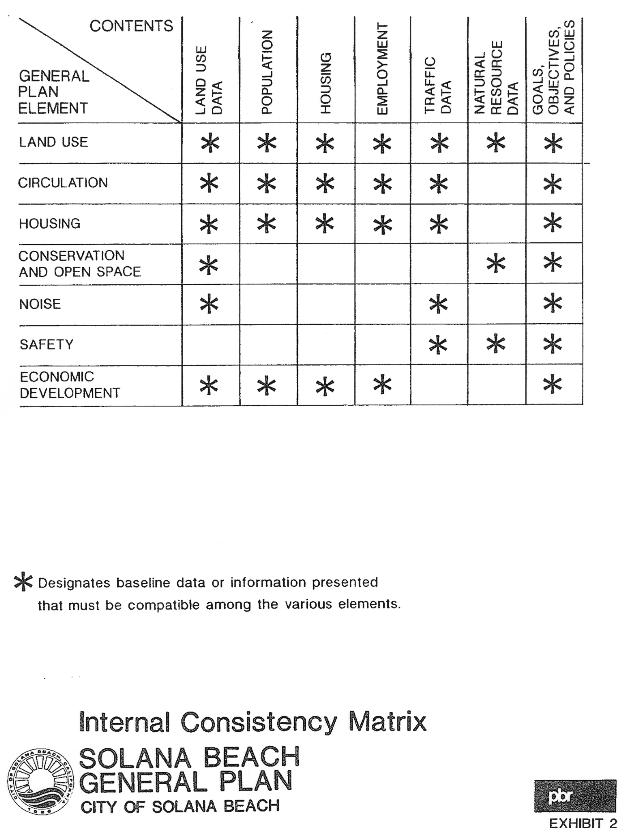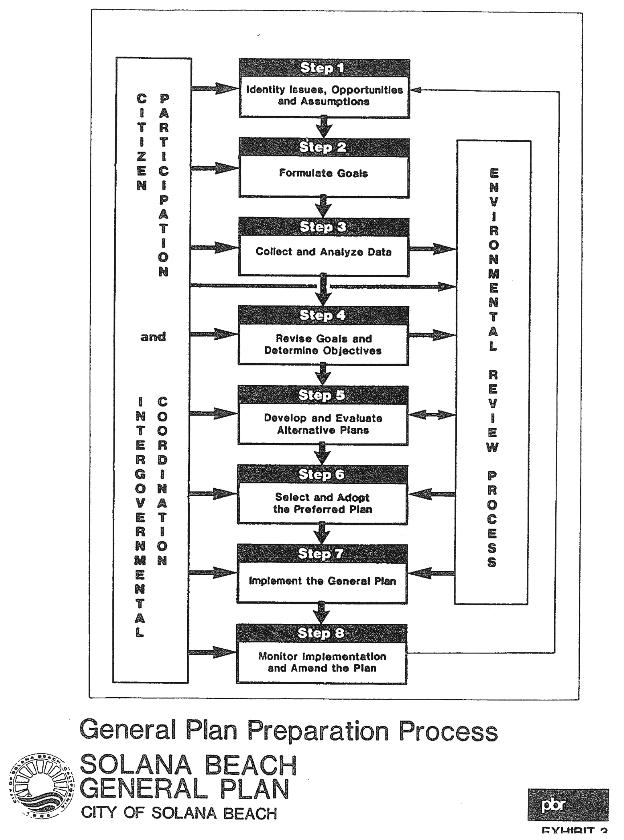INTRODUCTION
1.0 City of Solana Beach – An Overview
Solana Beach is a small city located in southern California on the central coast of San Diego County. It overlooks the Pacific Ocean to the west from sloping green hills and sandstone bluffs. It is bounded on the north by the San Elijo Lagoon and the city of Encinitas. To the east lies the San Dieguito County Park, rural residences and the San Dieguito River Valley. The cities of San Diego and Del Mar form the southern boundary.
The majority of the citizens are year-round residents. There are churches and synagogues of many denominations, public and private schools and numerous recreational facilities. The city is approximately 95 percent developed and is undergoing reconstruction in a few areas.
In 1986, the citizens of Solana Beach voted to incorporate as a city to preserve a way of life and self determine goals for the future. Subsequent to being incorporated, a group of citizens were designated by the City Council to initiate the process for preparing the state-mandated general plan for the city.
More than 80 dedicated individuals from all walks of life were organized into a cohesive, active group called the “Citizens Advisory Committee.” They divided the city into seven areas for purposes of defining and evaluating land use, both existing and future. In addition, they formed committees to establish guidelines for each of the eight general plan elements. The end product is this document.
This general plan evaluates, defines, and sets goals for development preservation and rehabilitation of distinct neighborhoods and commercial areas. Furthermore, it is the spirit and intent of this plan to achieve and sustain a high quality of life for citizens and visitors alike through harmonious integration of pedestrians and vehicles, social and civic activities, recreational and economic opportunities and by the preservation of the city’s natural beauty, now and in the future.

2.0 Purpose of the General Plan
The major purposes of this general plan are:
1. To articulate goals for the future physical, social, and economic development of the city of Solana Beach;
2. To describe public policies adopted to attain community goals; and
3. To provide the basis for informed decisionmaking and to establish a basis for subsequent planning efforts such as the preparation of specific plans and special studies.
As a whole, the goals, objectives, and policies set forth in this general plan provide the framework for guiding the long-term development of the city. Section 4.2 of this Introduction discusses the range of measures available to the city for implementing its adopted goals, objectives, and policies.
3.0 Legal Authority and Requirements
3.1 Government Code Sections
State Law (Section 65300) requires each city to adopt a comprehensive, long term and internally consistent general plan for the physical development of the city and any land outside the city’s boundaries which is felt to bear relation to the city’s planning. The state requires cities to adopt general plans based on the belief that the future growth of the state is determined largely through local actions.
State policies pertaining to general plans can be summarized as follows:
■ To improve the quality of life in California by preserving and using the resources of the land in economically and socially desirable ways. (Adapted from Government Code Section 65030.)
■ To maintain, improve, and enhance the quality of air, water, and land according to state and national standards and local needs. (Adapted from Public Resources Code Section 21000 et seq.)
■ To ensure the preservation of open space for scenic beauty, recreation, the conservation of natural resources, and the protection of public health and safety. (Adapted from Government Code Sections 65560 and 65561.)
■ To ensure the provision of “decent housing and a suitable living environment for every California family.” (Adapted from Health and Safety Code Section 37112 and Government Code Section 65580(a).)
■ To conserve water, air, and energy by considering the effect of future development on these resources and by encouraging new development which uses public facilities currently available and minimizes the need to travel. (Adapted from Public Resources Code Section 21001.)
■ To provide transportation facilities and services that are adequate and efficient and that significantly reduce hazards to human life, pollution, noise, disruption of community organization, and damage to the natural environment. (Adapted from Government Code Section 14000.)
■ To identify and reduce hazards to health and property from natural and man-made conditions, including floods, fires, landslides, soil erosion, seismic activity, airplane crashes, excessive noise, hazardous wastes, and congested and unsanitary living conditions. (Adapted from Water Section Code 8401, Government Code Section 26215, Public Utility Code Section 21670, and Health and Safety Code Sections 25101, 33071, and 37121.)
■ To use reasonable and practical means in carrying out the general plan so that it will serve as a pattern and guide for orderly physical development and the preservation and conservation of open space land and as a basis for the efficient expenditure of public funds. (Adapted from Government Code Section 65400(a).)
■ To ensure that land use decisions are made with full knowledge of the long- and short-term economic and fiscal implications, as well as environmental effects. (Adapted from Government Code Section 65030.2.)
3.2 Mandated Elements
Government Code Section 65302 specifies that every city and county shall include the following seven elements in its general plan:
■ Land Use Element
■ Circulation Element
■ Housing Element
■ Conservation Element
■ Open Space Element
■ Noise Element
■ Safety Element
Although these elements are mandatory, they may be combined at the discretion of the city as long as the city complies with all requirements governing the content and adoption of mandatory elements.
3.3 Optional Elements
Government Code Section 65303 states that local governments may adopt “any other elements or address any other subjects which...relate to the physical development of the...city.”
The city of Solana Beach has determined that an Economic Development Element, which is an optional element, is appropriate for inclusion in this general plan. It should be noted that optional elements have the same force and effect as required elements.
3.4 Internal Consistency
Since all elements of the general plan have equal status, no element may supersede another element. Therefore, as required by Government Code 65300.5, the general plan and elements and parts thereof must comprise an integrated, internally consistent, and compatible statement of policies for the adopting agency. All baseline data, goals, objectives, and policies adopted in the general plan must be consistent. Exhibit 2 provides a matrix which reflects the consistency of the elements comprising this general plan.
3.5 Relationship to Other Planning Documents
To make the long-range comprehensive planning of the general plan more meaningful, a link between the general plan and day-to-day actions of the city is required. In California, the general plan has been institutionalized through the enactment of statutes requiring consistency of certain local actions with the general plan. Additional statutes, while not mandating consistency, require findings or a report on whether proposed actions conform to the general plan. The state’s general rule for consistency determination is stated as:
An action, program, or project is consistent with the general plan if it, considering all aspects, will further the objectives and policies of the general plan and not obstruct their attainment.
Following is a list of provisions in state law that require local actions and documents to be consistent with the general plan:
Zoning:
Government Code Section 65860 requires that city and county zoning ordinances be consistent with the general plan.

Subdivisions:
Government Code Sections 66473.5 and 66474 require that subdivision and parcel map approvals in all jurisdictions be consistent with the general plan.
Reservations of Land within Subdivisions:
Government Code Section 66479 requires that reservations of land for parks, recreational facilities, fire stations, libraries, and other public uses within a subdivision conform to the general plan.
Open Space:
Government Code Section 65566 requires that acquisition, disposal, restriction, or regulation of open space land by a city or county be consistent with the open space element of the general plan.
Government Code Section 65567 prohibits the issuance of building permits, approval of subidivision maps, and adoption of open space zoning ordinances that are inconsistent with the open space element of the general plan.
Government Code Section 65910 requires that every city and county adopt open space provisions in their zoning ordinances consistent with the open space element of the general plan.
Government Code Section 51084 requires cities and counties accepting or approving an open space easement to make a finding that preservation of the open space land is consistent with the general plan.
Capital Improvements:
Government Code Sections 65401 and 65402 require the review of and report on the consistency of proposed city, county, and special district capital projects, including land acquisition and disposal, with the applicable general plan.
Development Agreements:
Government Code Section 65867.5 requires that development agreements between developers and local governments be consistent with the general plan.
Special Housing Programs:
Health and Safety Code Section 50689.5 requires that housing and housing programs developed under Health and Safety Code Section 50680 et seq. for the developmentally disabled, mentally disordered, and physically disabled be consistent with the housing element of the general plan.
Parking Authority Projects:
Street and Highway Code Section 32503 requires that parking authorities, in planning and locating any parking facility, are “subject to the relationship of the facility to any officially adopted master plan or sections of such master plan for the development of the area in which the authority functions to the same extent as if it were a private entity.”
Project Review under CEQA:
Title 14, California Administrative Code Section 15080 requires examination of projects subject to the provisions of the California Environmental Quality Act for consistency with the general plan.
Mineral Resources:
Public Resources Code Section 2763 requires that city and county land use decisions affecting areas with minerals of regional or statewide significance be consistent with mineral resource management policies in the general plan.
Transmission Lines:
Public Utilities Code Section 12808.5 requires cities and counties approving electrical transmission and distribution lines of municipal utility districts to make a finding concerning the consistency of the lines with the general plan.
3.6 Environmental Assessment
The California Environmental Quality Act (CEQA) requires that environmental issues related to the adoption of a general plan be addressed either in the general plan itself or through the preparation of an Environmental Impact Report (EIR). As defined by Section 15206 of the State CEQA Guidelines, a proposed general plan shall be considered as a project of statewide, regional, or areawide significance if it involves the preparation of an EIR and shall be subject to review by state agencies. Pursuant to CEQA, an EIR has been prepared for the Solana Beach General Plan and is provided as a companion document.
4.0 The General Plan Process
4.1 Preparation Process
This general plan is the product of a team effort involving the citizens of Solana Beach, the Solana Beach City Council, city staff, and a multi-disciplined team of consultants. As illustrated by Exhibit 3, the general plan process involved the following key aspects:
1. The identification and analysis of issues.
2. The establishment of goals and objectives.
3. The development and evaluation of alternative land use plans.
4. The selection of a preferred alternative and the establishment of an implementation program.

Continuous opportunities for citizen participation were provided throughout the process. The primary arena for public involvement was an extensive series of General Plan Advisory Committee meetings and workshops.
This citizen participation was essential to the identification of community values and goals which served as the foundation of the plan. Further, the General Plan Advisory Committee reviewed work in progress and provided recommendations concerning key decisions to be reached during the process.
4.2 General Plan Implementation
The city of Solana Beach has several implementation measures available to carry out its adopted goals and objectives. Within the general plan itself, each element contains policies which call for specific implementing actions to be taken by the city. Other polices are set forth which call for subsequent programs and actions to be taken which will implement the provisions of the general plan.
In addition to the measures established in the general plan itself, other implementation measures are derived from the city’s corporate and police powers granted by state law. The adoption of a zoning ordinance is the city’s principal instrument for implementing the general plan and is derived from the police power given to the city. This ordinance regulates land use by dividing the city into zones and specifying permitted uses, allowable development intensities, minimum lot size, building height and setback limits, and other development parameters within each land use zone.
Other implementation measures derived from the city’s police power include the city’s power to regulate subdivisions, to adopt specific plans, to enforce building and housing codes, to establish park dedication requirements, and to utilize environmental and design review procedures when considering development proposals.
Implementation measures derived from the city’s corporate powers include the construction of streets, water, and sewer facilities, the acquisition and development of parkland, the acquisition of sites for low income housing, and the acquisition of open space, conservation, or scenic easements.
4.3 General Plan Amendment Procedures
A. Notwithstanding anything in Subsection (b) of Section 65358 of the Government Code to the contrary, no Element of this General Plan shall be amended more than twice per calendar year,** except for (i) amendments necessary to comply with State or Federal law; (ii) amendments to implement or obtain certification of a local coastal plan; or (iii) amendments specified in Subsections (c) or (d) of Section 65358.
B. Notwithstanding anything in Section 65356 of the Government Code to the contrary, any amendment to, or repeal or readoption of, the Land Use Element (including the Land Use Map) shall be subject to paragraph E, below.*,****
C. Notwithstanding anything in Section 65356 of the Government Code to the contrary, any amendment to, or repeal and readoption of, any other element requiring an amendment to the Land Use Element in order to maintain internal consistency between the various Elements of this General Plan, shall be subject to paragraph E, below.***,****
D. Notwithstanding anything in Sections 65090, 65091, 65353 or 65355 of the Government Code to the contrary, if a proposed General Plan Amendment would affect the permitted uses or intensity of uses of one or more parcels of real property, mailed notice of the public hearing shall be given to the owner (as identified pursuant to Government Code Section 65091) of each parcel of real property located within 1/2 mile of the real property.***
E. No General Plan Amendment, including Specific Plan adoptions or changes, shall be adopted which would:
1. change, alter or increase the General Plan Residential Land Use categories; or
2. change any land use designation to any other, except changes to land already designated residential that clearly result in a reduction in intensity or density of said land use designated as residential:
unless and until such action is approved by a majority of voters in the City.
This provision shall not apply to amendments which are necessary to comply with state or federal law or which are necessary to implement or obtain certification of the local coastal program.****
* Resolution 93-5, adopted Jan. 19, 1993 (see B. above)
** Resolution 96-45, adopted May 6, 1996 (see A. above)
*** Resolution 97-5, adopted Jan. 7, 1997 (see C. and D. above)
**** Ordinance 266, General Plan Amendment language effective 5-27-98, adopted as a citizens’ initiative, Proposition T, the Solana Beach Community Protection Act, at the 11-7-2000 General Municipal Election and by the City Council on 12-5-00 (see B, C and E above)


